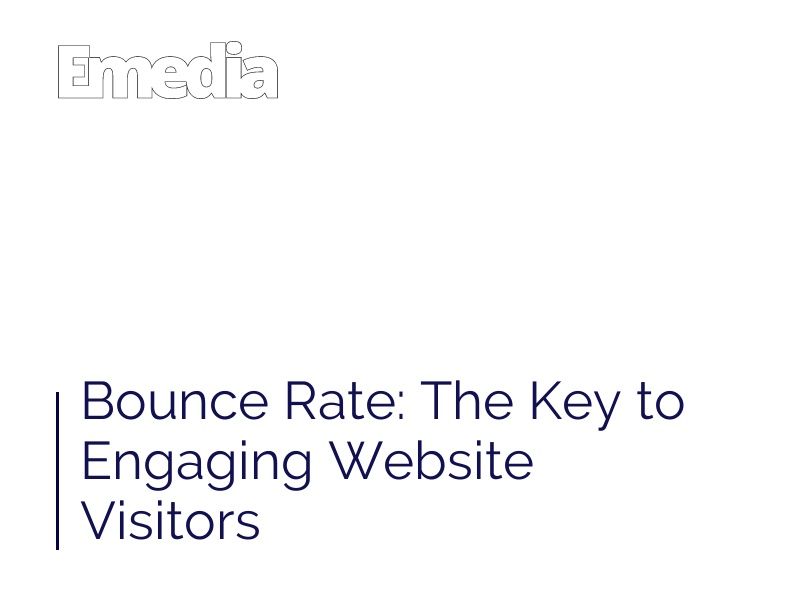In the realm of online success, the effectiveness of a website in engaging visitors and encouraging them to explore further is paramount. One metric that provides valuable insights into this aspect is the bounce rate, which measures the percentage of website visitors who leave after viewing only one page.
A lower bounce rate signifies better user engagement, and understanding and analyzing this metric can help identify areas for improvement in website design, content relevance, and user engagement. Additionally, optimizing bounce rate can lead to increased user retention, improved conversion rates, and the conversion of visitors into loyal customers.
Key Takeaways
- Bounce rate measures the percentage of website visitors who leave after viewing only one page.
- A high bounce rate may indicate issues with website design, content relevance, or user engagement.
- Bounce rate can be analyzed for different pages, campaigns, or traffic sources to identify areas for improvement.
- Strategies to reduce bounce rate include improving website loading speed, enhancing content quality and relevance, optimizing website design, and conducting A/B testing.
Understanding Bounce Rate: What It Means for Your Website
This article provides a comprehensive understanding of the bounce rate and its implications for your website's performance, offering valuable insights into the percentage of visitors who leave after viewing only one page.
Bounce rate is a crucial metric that indicates how effectively your website engages visitors and encourages them to explore further. It is calculated by dividing the number of single-page visits by the total number of entries to a website and is typically expressed as a percentage.
A high bounce rate may indicate issues with website design, content relevance, or user engagement. Monitoring bounce rate trends over time can provide insights into the effectiveness of marketing efforts, and optimizing landing pages based on bounce rate analysis can improve conversion rates.
Importance of Bounce Rate in User Engagement
During the discussion on the importance of bounce rate in user engagement, it is crucial to analyze the factors that contribute to visitor behavior and identify areas for improvement.
Bounce rate is a metric that measures the percentage of website visitors who leave after viewing only one page. It indicates the effectiveness of a website in engaging visitors and encouraging them to explore further. A high bounce rate may indicate issues with website design, content relevance, or user engagement.
By analyzing bounce rate, marketers can identify pages that need improvement or optimization to increase user retention. It can also help identify opportunities for A/B testing to improve user engagement.
Analyzing Bounce Rate: Factors to Consider
In the ongoing discussion on analyzing bounce rate, it is imperative to thoroughly examine the various factors that contribute to user behavior and their impact on website performance. Bounce rate, which measures the percentage of website visitors who leave after viewing only one page, is a critical metric for evaluating user engagement and website effectiveness.
Factors such as page load speed, content quality, and user interface can influence bounce rate. It is also essential to segment bounce rate by traffic source and device type to identify low-quality traffic sources and understand differences in user behavior across devices.
Additionally, comparing bounce rates for different landing pages can highlight opportunities for optimization. By analyzing these factors, marketers can gain valuable insights into user behavior and make informed decisions to reduce bounce rate and improve website performance.
Bounce Rate Vs. Exit Rate: Key Differences to Know
The comparison between bounce rate and exit rate sheds light on the distinct metrics that provide valuable insights into user behavior and overall website performance.
Bounce rate measures the percentage of visitors who leave a website after viewing only one page, indicating the effectiveness of user engagement. Exit rate, on the other hand, measures the percentage of visitors who leave a website from the last page they visited, reflecting overall visitor behavior.
Understanding the difference between bounce rate and exit rate is crucial for optimizing website performance and improving user experience. By analyzing these metrics, marketers can identify areas for improvement, optimize landing pages, and increase conversion rates.
Key differences between bounce rate and exit rate:
- Bounce rate measures initial engagement, while exit rate reflects overall visitor behavior.
- Bounce rate focuses on the entry page, while exit rate considers the last page visited.
- Both metrics provide valuable insights into user behavior and website performance.
Strategies to Reduce Bounce Rate and Increase Visitor Engagement
Implementing strategic changes frequently and consistently can effectively reduce bounce rate and enhance visitor engagement on a website. A high bounce rate indicates that visitors are not finding what they are looking for or are not sufficiently engaged to explore further.
To reduce bounce rate, it is important to improve website loading speed, enhance content quality and relevance, and optimize website design for easy navigation and intuitive user interface. Clear call-to-action buttons should be implemented to guide visitors to further explore the website.
Conducting A/B testing can help identify and implement effective changes to reduce bounce rate. By consistently analyzing and optimizing bounce rate, marketers can increase visitor engagement and improve the chances of converting visitors into customers.
Conclusion
In conclusion, understanding and analyzing bounce rate is crucial for businesses to improve user engagement and website success.
By optimizing bounce rate, businesses can increase user retention, improve conversion rates, and ultimately convert visitors into loyal customers.
Strategies to reduce bounce rate include improving website design, relevance of content, and user engagement.
By implementing these strategies, businesses can effectively engage website visitors and encourage them to explore further, leading to increased online success.
